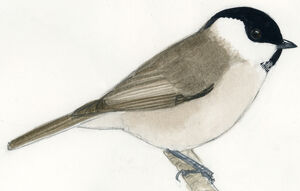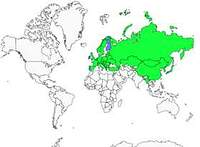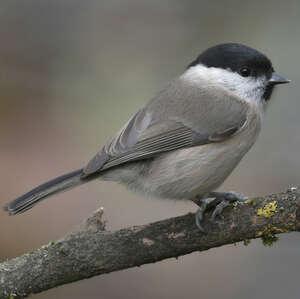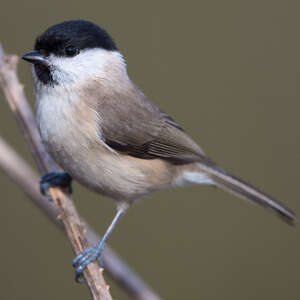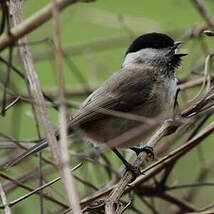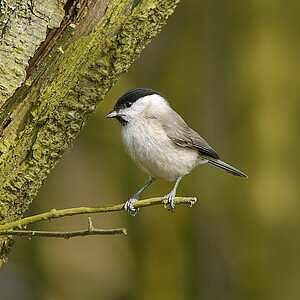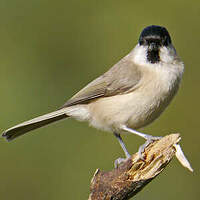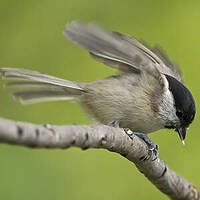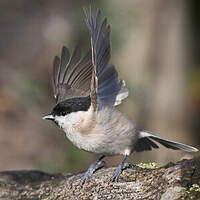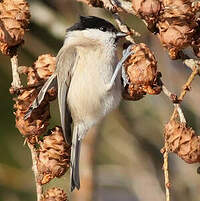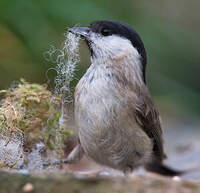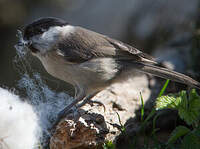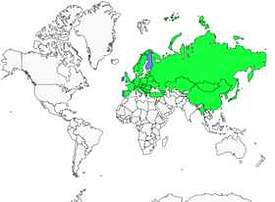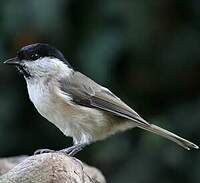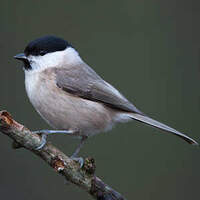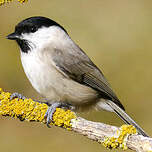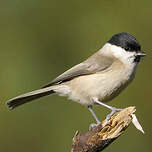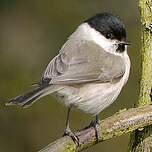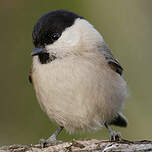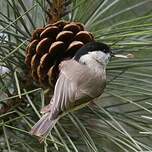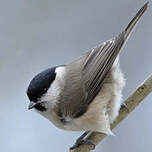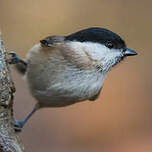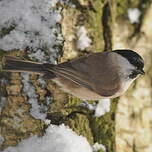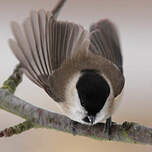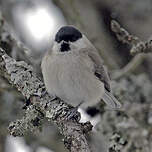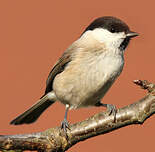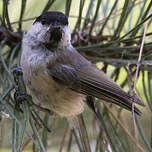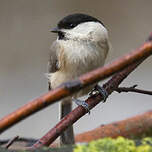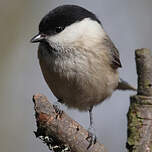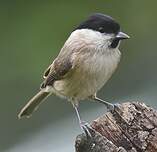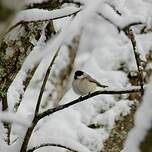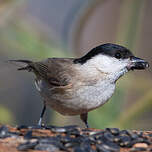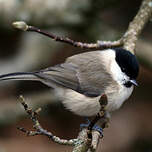Marsh Tit
Poecile palustris - Mésange nonnette
Identification
The tit family includes two species that look quite similar and can be confused with each other: the Marsh Tit and the Willow Tit. As with many birds, the best way to tell them apart is to pay attention to their voices, as we will see in the following chapter.
The Marsh Tit has seven subspecies which show small differences from each other. To identify those present in France, we will focus on the nominate subspecies palustris. [Between brackets, its counterpart in the Willow Tit]. The head carries a blackish cap which encircles the black eye and continues to the nape. In adults, this black is glossy [dull cap]. The cheeks are white and a very well-defined line separates them from the pale rump [white cheeks continues to the black nape]. A small and clearly-defined moustache occupies the chin [larger, less sharply-defined moustache]. The beak is black with a light stain at its base [all-black beak]. The upper parts, body and wing covers, are of a grayish-brown hue. The lower parts are somewhat red-tinged white, particularly around the flanks [more obviously rufous lower parts]. The primaries and secondaries are blackish with thin streaks of light which do not form larger paler patches on the secondaries [obvious whitish patch on the secondaries]. The legs are grey. Finally, a clue which can only be assessed when handling the bird is the tip of its tail. It's rather truncated in the Marsh Tit, with minimum 4mm distance between the central and the external rectrices [more than 4mm].
Juveniles look like adults, but have a matte black flush on their head. Their upper parts are paler and a bit grayer. The moustache is less developed and almost checkerboard.The cheeks and underside are whiter.
Subspecific information 10 subspecies
- Poecile palustris palustris (Scandinavia to n Iberian Pen. east to Poland, the Balkans and Greece)
- Poecile palustris dresseri (Wales, c and s England and w France)
- Poecile palustris italicus (French Alps, Italy and Sicily)
- Poecile palustris stagnatilis (e Europe to the s Urals and nw Turkey)
- Poecile palustris kabardensis (Caucasus area and ne Turkey)
- Poecile palustris brevirostris (sc and se Siberia, n Mongolia, Manchuria and Liaoning. ne China. and extreme n Korea)
- Poecile palustris ernsti (Sakhalin I.)
- Poecile palustris hensoni (s Kuril Is. and n Japan)
- Poecile palustris jeholicus (n Hebei. ne China. and n Korea)
- Poecile palustris hellmayri (e China and s Korea)
Foreign names
- Mésange nonnette,
- Carbonero palustre,
- chapim-palustre,
- Sumpfmeise,
- barátcinege,
- Glanskop,
- Cincia bigia,
- entita,
- Løvmeis,
- sýkorka hôrna,
- sýkora babka,
- Sumpmejse,
- viitatiainen,
- mallerenga d'aigua,
- Laufmeisa,
- sikora uboga,
- purva zīlīte,
- močvirska sinica,
- Черноголовая гаичка,
- ハシブトガラ,
- 沼泽山雀,
- entita,
- 沼澤山雀,
Voice song and call
The vocabulary of cries is rich: Istié, pistié, pisit piu, pistiu, sit sit sitiu, pistiu hé hé hé hé.... The pistié is typical. The cry is sometimes repeated and then takes on the value of a song tsipiu tsipiu tsipiu...
The song consists of the rapid repetition of the same note, for example piu piu piu piu piu piu piu piu or tiup tiup tiup tiup tiup tiup tiup tiup or other variants.
Habitat
Marsh Tits typically nest in deciduous forests, generally oaks or beeches, when sufficiently extensive in area. During the nesting season they also frequent mixed forests, wooded areas along rivers, alder groves, heavily-wooded agricultural land, orchards, and occasionally parks. They are also found in gardens, and even reed thickets in Japan. On the other hand, they rarely penetrate into urban areas. In the southern Siberian taiga and in Sakhalin, they show a preference for riverine groves of aspens, birches, and cherry trees, avoiding conifers. Nevertheless, in certain regions (England, Denmark, Austria, Caucasus, Mongolia, and Korea) they can settle in poplars where Great Tits are absent.
Marsh Tits live in Europe (except for the Iberian Peninsula, Ireland, Greece, and northern Scandinavia) and in Asia Minor. Their range is discontinuous and picks up once again after hundreds of kilometres in the eastern part of Asia, in northern Mongolian, eastern Siberia, Manchuria, north-eastern China, and Korea. Numerous subspecies are distributed throughout this vast geographical area. The ssp dresseri is present in England and the northwestern part of France (Brittany, Anjou, Poitou).The nominate subspecies palustris is mostly found in central and eastern Europe, up to Poland and Bulgaria. It is also present in central and southern France, Switzerland and the Austrian Alps. The subspecies stagnatilis lives in northern Turkey and European Russia. The subspecies italicus lives in the French Alps and in Italy. The subspecies karbadensis can be observed in the north of the Caucasus. East Asia: the subspecies brevirostris is present in eastern Siberia, Mongolia, Amur and Ussuri countries, northeastern China and Korea. The subspecies ernsti lives exclusively on Sakhalin. The subspecies bensoni can be found in the southern part of the Kuril archipelago and on Hokkaido. Finally, the subspecies hillmayri is a resident in northern China and South Korea.
Behaviour character trait
It is a familiar species, which is curious but less gregarious than most other tits. One of the interesting aspects of the Marsh Tit's life is that couples are stable.
Males and females, once united in February-March, stay together even in autumn and winter, while frequenting other Marsh Tits, or even other groups of tits, while always staying on or near their territory because it is a sedentary bird.Marsh Tits mainly sing during the period from mid-January to the end of June. They are mainly active at dawn but also express themselves at any time of the day. Males express their territoriality with their singing, which can lead to singing duels.
Dietfeeding habits
The Marsh Tit's diet consists mainly of insects at various stages of their development, including chitin-shelled Coleoptera, aphids, flies and spiders. In the autumn, the Marsh Tit will often cache seeds and nuts such as acorns in crevices in bark, beneath moss or lichen, in leaf litter, or in a cavity in the ground.
Reproduction nesting
In spring, usually starting in April, each pair occupies their nesting territory and the females carefully examine available tree holes.
They are not overly picky and nest just as easily near the ground as up to ten metres or higher. The nest is made of moss, lichens, pieces of grass and hair. The female lays 7 to 10 white eggs with some scattered brown-red spots. After two weeks of incubation which she alone undertakes, the chicks hatch and the male then helps with the feeding for 17 - 19 days. When the juveniles leave the nest, the parents continue to feed them for some time. Unlike what other tits generally do, the Marsh Tit only nests once per season.Geographic range
The breeding range of the Marsh Tit is divided into two groups, one centered on temperate Europe and the other on East Asia covering southern Russia, northern Mongolia, northeastern China and the Korean peninsula. It is sedentary there. The European range excludes Ireland, most of Spain, most of northern Fennoscandia, and extends eastwards as far as southern Ural. It is absent from Mediterranean-type habitats.
Threats - protection
Sources of information
- IOC World Bird List (v14.2), Gill, F and D Donsker (Eds). 2024-04-18.
- xeno-canto, Sharing bird sounds from around the world,
Other sources of interest
 Specification sheet created on
28/10/2023 by Didier Collin with help of Daniel Le-Dantec
Specification sheet created on
28/10/2023 by Didier Collin with help of Daniel Le-Dantec partially rewritten on 00/00/0000 by Jean François
Translation by AI Oiseaux.net
© 1996-2025 Oiseaux.net
- Accipitriformes
- Aegotheliformes
- Anseriformes
- Apodiformes
- Apterygiformes
- Bucerotiformes
- Caprimulgiformes
- Cariamiformes
- Casuariiformes
- Charadriiformes
- Ciconiiformes
- Coliiformes
- Columbiformes
- Coraciiformes
- Cuculiformes
- Eurypygiformes
- Falconiformes
- Galliformes
- Gaviiformes
- Gruiformes
- Leptosomiformes
- Mesitornithiformes
- Musophagiformes
- Nyctibiiformes
- Opisthocomiformes
- Otidiformes
- Passeriformes
- Pelecaniformes
- Phaethontiformes
- Phoenicopteriformes
- Piciformes
- Podargiformes
- Podicipediformes
- Procellariiformes
- Psittaciformes
- Pterocliformes
- Rheiformes
- Sphenisciformes
- Steatornithiformes
- Strigiformes
- Struthioniformes
- Suliformes
- Tinamiformes
- Trogoniformes

